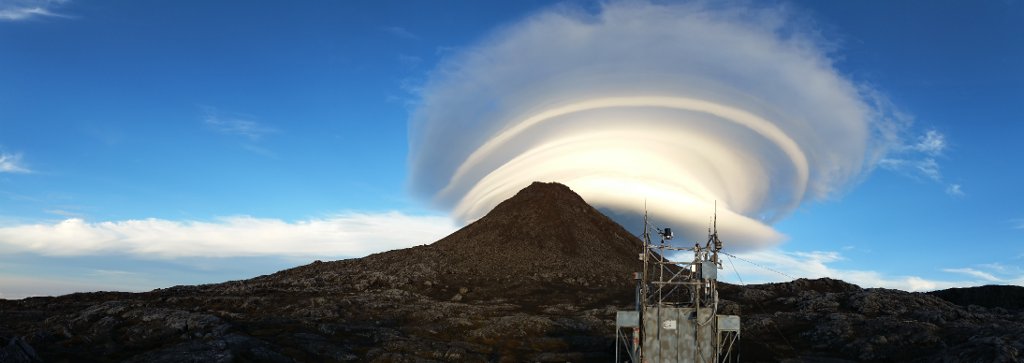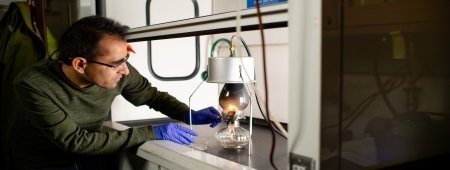Michigan Tech Researchers to Study Atmospheric Aerosols at PICO Mountain Research Observatory

In 2001, Richard Honrath established an atmospheric research station on the top of Mt. Pico, a cold, lonely, extinct volcano in the Azores.
Mt. Pico is the highest point in the Portuguese island chain and the only spot in the mid-Atlantic where the air is high enough to escape the effects of the ocean environment. For Honrath, director of Michigan Technological University’s atmospheric sciences program, the mountain’s remoteness and its elevation—7,713 feet—made it an ideal spot to study pollutants drifting east from North America. Until his death in 2009, the station was a center of Honrath’s research, generating a stream of discoveries on a variety of atmospheric gases, including ozone, nitrogen oxides and carbon dioxide from wildfires.
Since then, several scientists have carried on related work at the PICO (for Pico International atmospheric Chemistry Observatory) Mountain Observatory. Now, two major research projects in a different area of atmospheric science will take advantage of Mt. Pico’s unique geography.
Wife and husband Lynn and Claudio Mazzoleni have received separate grants to characterize aerosols at the PICO Mountain Observatory.
Aerosols—a catch-all term for tiny particles and droplets suspended in the atmosphere—have attracted attention of late for their role in climate change. They reflect sunlight back into space, which can be a force for global cooling, or they can absorb sunlight, which would cause warming. They can also affect clouds in intricate ways that change anything from how reflective they are to how much rainfall they yield.
Figuring out their role is no easy task. Aerosols range from complex compositions like that of smoke to salt kicked up by ocean waves, and they interact with one another in a dizzying cascade of chemical reactions.
Lynn Mazzoleni, an assistant professor of chemistry, will focus on understanding aerosols’ chemistry and how they interact with sunlight as the lead investigator on a $910,000 National Science Foundation project. The three-university endeavor includes the University of Illinois at Urbana-Champaign and the University of Colorado. Michigan Tech’s share of the funding is $546,000.
Claudio Mazzoleni, an assistant professor of physics, is a coinvestigator on the project and is lead investigator on a related two-year, $300,000 US Department of Energy grant to characterize how much sunlight aerosols are reflecting or absorbing and how their reflective properties change as they drift across the cloud-covered Atlantic. In addition, the project could give the DOE a permanent site for gathering atmospheric data in the future.
Several other researchers are contributing to research efforts at Mt. Pico, including Research Scientist Chris Owen of the Michigan Tech Research Institute; Research Scientist Mike Dziobak and Assistant Professor Louisa Kramer of the Department of Geological and Mining Engineering and Sciences; Paulo Fialho of the University of the Azores; and Professor Noel Urban and Associate Professor Judith Perlinger of the Department of Civil and Environmental Engineering.
The same characteristics that prompted Honrath to establish the PICO Mountain Observatory make it a perfect spot to study aerosols.
Because PICO is so high above the ocean, any aerosols sampled there are almost guaranteed to have drifted east from the continent. “That’s the beauty behind Richard’s idea to put this research station in the mid-Atlantic,” Lynn Mazzoleni said. Air pollution from Canada and the US is often overlooked, she noted. “Emissions from China are carefully monitored on the West Coast,” she said. “People can actually see an aerosol plumes coming off of Asia. But the effect of aerosols from North America on Europe hasn’t been well studied.”
“Aerosols aren’t static,” said Claudio Mazzoleni. “They are constantly changing, and understanding that is important to understanding aerosols’ role in climate change.”
While they are bringing a new research focus to the PICO Mountain Observatory, the Mazzolenis do not view themselves as picking up Honrath’s torch.
“We are really more interested in collaborating with him via his former students, postdocs and collaborators,” Lynn Mazzoleni said. “We’re not taking over the site nor the evaluation of trace gases.”
“When I came here for an interview, Richard was one of the people I talked with, and he said it would be great to have aerosol instruments up there,” Claudio added. “He introduced us to the site, and it was obvious that the effort he made at Pico was incredible. We are so grateful. Without his pioneering vision and years of research at the site, we couldn’t be doing this.”
Michigan Technological University is an R1 public research university founded in 1885 in Houghton, and is home to nearly 7,500 students from more than 60 countries around the world. Consistently ranked among the best universities in the country for return on investment, Michigan's flagship technological university offers more than 185 undergraduate and graduate degree programs in science and technology, engineering, computing, forestry, business, health professions, humanities, mathematics, social sciences, and the arts. The rural campus is situated just miles from Lake Superior in Michigan's Upper Peninsula, offering year-round opportunities for outdoor adventure.




Comments